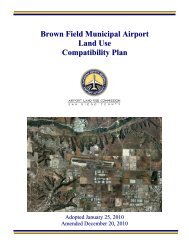Draft EA - San Diego International Airport
Draft EA - San Diego International Airport
Draft EA - San Diego International Airport
You also want an ePaper? Increase the reach of your titles
YUMPU automatically turns print PDFs into web optimized ePapers that Google loves.
SAN DIEGO INTERNATIONAL AIRPORT – PROPOSED RUNWAY 9 DISPLACED THRESHOLD<br />
3.2.2.4 West of <strong>Airport</strong><br />
The former Naval Training Center (NTC) property, comprising approximately 541 acres, is located west of the<br />
<strong>Airport</strong> on the west side of the Navy Boat Channel. The NTC site has been redeveloped as Liberty Station.<br />
Uses include residential, commercial, office, recreational, educational, and civic uses. 11<br />
3.2.3 EXISTING ZONING<br />
Zoning for the City of <strong>San</strong> <strong>Diego</strong> is planned and mapped by the Development Services Department of the<br />
City. 12<br />
Generally, zoning in the immediate areas surrounding the <strong>Airport</strong> tend to be commercial or industrial in<br />
use, which is consistent with the current land use for these areas.<br />
Areas to the west of the <strong>Airport</strong> are currently zoned for commercial, residential, and open space uses.<br />
Properties to the east and north of the <strong>Airport</strong> are zoned for commercial, residential, and industrial uses.<br />
South of the <strong>Airport</strong> consists of CPAs that are not designated for specific uses. Within these broad zoning<br />
designations are specific zones with distinct classifications and restrictions. These specific designations vary in<br />
development intensity, the mix of uses, and types of uses allowed.<br />
3.3 Noise<br />
The FAA has developed specific guidance and requirements for the assessment of aircraft noise in order to<br />
comply with NEPA requirements. The methodology to be used in conducting aircraft noise analyses is<br />
established in FAA Order 1050.1E. The FAA has determined that the cumulative noise exposure of individuals<br />
resulting from aircraft noise must be established in terms of the yearly day-night average sound level (DNL)<br />
metric, but accepts the use of the CNEL for aircraft noise evaluations in California. 13<br />
CNEL is the average noise level over a 24-hour period with a 5 dB penalty applied to evening operations (i.e.,<br />
operations between 7 p.m. to 10 p.m.) and a 10 dB penalty applied to nighttime operations (i.e., operations<br />
between 10 p.m. and 7 a.m.). The 5 dB and 10 dB increases during evening and nighttime hours, respectively,<br />
are intended to account for the added intrusiveness of aircraft noise during time periods when ambient noise<br />
due to vehicle traffic and other sources is typically less than during the daytime. CNEL is similar to DNL;<br />
however DNL does not add a 5-dB penalty to evening operations.<br />
11<br />
12<br />
13<br />
City of <strong>San</strong> <strong>Diego</strong>, Naval Training Center Overview, http://www.sandiego.gov/ntc/overview/index.shtml, (accessed: December 20, 2011).<br />
Development Services Department, City of <strong>San</strong> <strong>Diego</strong>, Official Zoning Map, http://www.sandiego.gov/ developmentservices/zoning/zoninggridmap.shtml,<br />
(accessed: December 12, 2011).<br />
The FAA definition of "significance" is specified using the day-night average sound level (DNL) metric. The FAA recognizes the use of the<br />
Community Noise Equivalent Level (CNEL) for aircraft noise evaluations in California. See FAA Order 1050.1E, Appendix A, Section 14 for<br />
FAA’s acceptance of CNEL as a suitable substitute for DNL.<br />
Affected Environment<br />
[3-10]<br />
<strong>Draft</strong> <strong>EA</strong>
















